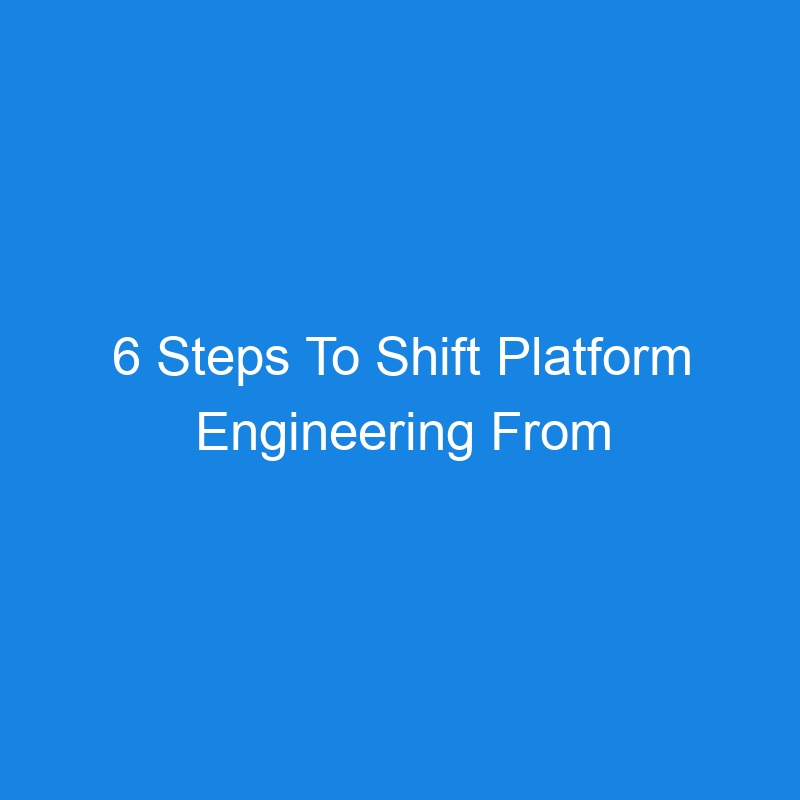
A common criticism of DevOps has been the lack of emphasis on the “dev” side of the equation, with most of the effort going towards optimizing the operational and security aspects. As a result, platform engineers have sometimes been perceived as mere “order takers,” simply fulfilling specific feature requests rather than proactively identifying and solving the underlying developer pain points.
In my job, I talk a lot with engineering leads at other companies about what’s working and not working in their platform engineering teams. One of the biggest complaints is that the teams spend most of their time throwing a surfeit of tools at various problems while rarely engaging with developers to understand their day-to-day challenges. That mentality leads them to a patchwork of disconnected solutions that fail to scale with a growing org and become more burdensome than helpful.
Instead of merely focusing on the backend infrastructure, platform engineers should start thinking like product managers. Product managers build tools and features based on user feedback and needs and prioritize user experience and value delivery.
The Product Manager Mindset for Platform Engineers
By embracing a product management mindset, platform engineers can create scalable, developer-centric platforms that developers love using.
Here’s how:
- Understand the User: Developers are the platform’s users, and their needs should be at the center of platform decisions. Rather than simply responding to explicit feature requests, platform engineers should dig deeper to uncover the root causes of developer pain points. This requires asking probing questions, understanding the underlying workflow challenges, continuously monitoring the platform, and delivering solutions that address the core problem, not just the surface-level symptoms.
For example, if a developer asks for faster build times, a product-minded platform engineer would explore the reasons behind the slow builds. Is it a bottleneck in the build system? Are there issues with dependencies? Is the build itself unoptimized? By addressing the root cause, the platform engineer can implement a more scalable solution beyond the specific request.
- Prioritize Features Based on Research and Impact: Similar to product managers who balance short-term feature requests with long-term product vision, platform engineers must prioritize platform enhancements based on their potential impact on developer workflows and the overall scalability of the platform. This means evaluating each request through the lens of an “Impact vs. Effort” quadrant, where high-impact, low-effort changes are prioritized for quick wins. At the same time, more significant initiatives are planned for long-term platform development.
For example, suppose several teams request automated test environments. Using tools like Docker Compose or Terraform to spin up testing environments quickly might be a high-impact, low-effort win.
- Build Iteratively with Continuous Feedback Loops: Rather than building a comprehensive platform from the ground up, platform engineers should adopt an agile, iterative approach — starting with an MVP and continuously gathering feedback to drive incremental improvements.
Minor, regular releases and user feedback loops in product development ensure the platform evolves based on real-world usage and developer needs. By shipping frequent enhancements, platform engineers can outrun technical debt and feature overload while maintaining a close connection with their “customers.”
- Measure Success with Data-Driven KPIs: I was chatting recently with another expert in the developer productivity space. He expressed frustration that, despite dedicating years to this subject, he still feels like the industry is getting it wrong. Measuring productivity effectively is deceptively complex, and it will take multiple iterations of observation and incremental improvements to tune it properly.
Define and monitor metrics that evaluate how effectively the platform is serving developers. KPIs should cover developer productivity, platform adoption, and overall system performance and reliability.
Metrics such as lead time for changes, deployment frequency, change failure rate, and mean time to resolve/repair (the DORA metrics) can provide valuable insights into the platform’s impact on developer workflows. Additionally, tracking platform efficiency, infrastructure uptime, and developer adoption rates can help platform engineers identify areas for improvement and ensure the platform is driving tangible business value.
- Engage with Adjacent Teams: During a recent consulting engagement with a Technical Program Manager, I learned that coordinating standards compliance across multiple business functions is often managed with a spreadsheet. This brittle solution makes it very difficult to deal with change, and the problem only gets more challenging as additional teams and engineers must have standards cascaded to them.
As product managers gather insights from multiple stakeholders, platform engineers should begin working with teams like security, SREs, infrastructure, and operations on day one to ensure the platform is secure, scalable, and aligned with organizational needs. Collaborating with these adjacent teams can even help those roles drive their initiatives more efficiently and uncover essential insights about requirements, potential risks, and opportunities for improvement. By integrating security checks, performance
monitoring and operational workflows into the platform, platform engineers can build solutions that balance developer productivity with broader organizational needs.
- Develop Systems Thinking: Great platform engineers are great systems thinkers who understand the underlying interplay between systems and the systems in which their users work. They know that the overall productivity of a team or organization is primarily constrained by the underlying set of systems in which that organization is forced to work. This principle drives and motivates a great platform engineer to build systems that are frictionless and satisfying to use.
By adopting a product management mindset, platform engineers can transform their roles from order-takers to strategic partners, empowering developers and driving organizational productivity to new heights. This approach shift benefits the platform’s end-users and aligns the platform engineering function with the broader business goals and priorities.
This article is part of The New Stack’s contributor network. Have insights on the latest challenges and innovations affecting developers? We’d love to hear from you. Become a contributor and share your expertise by filling out this form or emailing Matt Burns at mattburns@thenewstack.io.
The post 6 Steps To Shift Platform Engineering From Reactive to Proactive appeared first on The New Stack.
